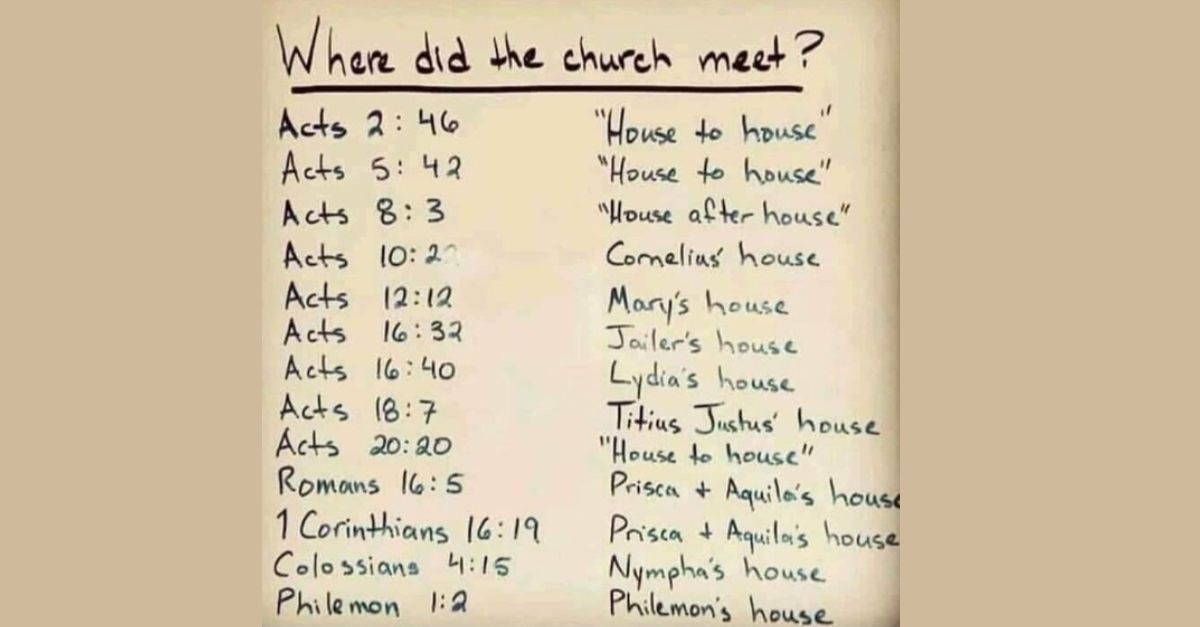I recently ran across a tweet that posted the following graphic in recognition of “National Back to Church Sunday”:

The attempted point was obvious: if you want to go back to church on “National Back to Church Sunday,” don’t go back to a “church” in the traditional sense, but instead find a house church or some other gathering in a home. After all, in the Bible, people met in homes.
Let’s begin by agreeing. Churches did meet in homes in the early church. Also, if a gathering of Christ followers chooses to meet in a home today as a church, or start a church by meeting in a home, or are forced to meet in a home due to persecution, or wish to pursue a “microchurch” strategy to infiltrate a community, that is a wonderful and perfectly acceptable thing to do.
There is nothing wrong with a body of believers meeting in a home.
But let’s think about the insinuation. Namely, churches should meet in homes, are supposed to meet in homes, or ought to meet in homes, based on the New Testament narrative. Should that be how we read the New Testament narrative?
No.
First, that’s all that we have on the matter. The New Testament narrative. There are two types of Scripture when it comes to gathering insight and instruction: narrative and didactic. And they fall into those two categories: narrative for insight, didactic for instruction. A narrative portion of Scripture describes something that happened, such as the account of Paul’s conversion on the road to Damascus. Didactic portions of Scripture give pointed instructions, such as the Ten Commandments.
One of the great hermeneutical errors is to confuse these two types of Scripture; specifically, treating narrative portions as didactic. For example, it would be an interpretive error to take the narrative of Paul’s conversion experience and conclude that authentic salvation must involve three days of blindness. No, that was a narrative portion of Scripture telling us the story of Paul’s conversion. It was not settled, didactic teaching on how to be saved.
There is little doubt that the early church often met in homes, and this is described throughout the narrative portions of the New Testament. But nowhere is there a single didactic statement or teaching that says that this is how, much less where churches are meant to be gathered.
(Further, the narrative also says that they met in the Temple courts. That was a large edifice, anything but a house, so let’s be comprehensive in our narrative retellings.)
But even more to the point, the early Christian church met in homes because they had no choice. There were no buildings – outside of the Temple – in which they could have met. Also, persecution soon exploded against the early Christian movement (most infamously under the Roman emperor Nero), and their meetings were quickly forced underground. Again, as you might imagine, in the only place possible which was in homes.
But any student of history knows that as the church grew and persecution waned, buildings were quickly built for the needs of the church. The earliest we know of was around 240 A.D. (the Dura-Europos Church in Syria), but that is simply the first we can clearly document. Some say the Monastery of St. Thaddeus in Iran was constructed in AD 66. But these are just ones we know about through archeology.
Such constructions were not seen as a loss of the early church’s dynamic but rather a gain for the early church’s growth and continued impact and influence. Just like a house provided certain necessities for gathering and communing, worshiping, and ministry, so did buildings. And those structures were needed. As Rodney Stark has charted the growth of the early church, by AD 100, there were around 7,500 followers worldwide. By the mid-300s, more than 30 million called themselves followers of Christ.
So let’s get the anti-building mentality out of our spiritual psyches as if buildings outside of homes are of little use, not biblical, are a waste of Kingdom resources, or take away from the pristine nature of the early church. You cannot get that from the New Testament, much less from the history of the church.
House churches have their place, but they were a necessity, not a choice, in the New Testament era. When other options eventually presented themselves, the Christian movement took full advantage of any and all use of “bricks and mortar” to further the cause of Christ.
We still can, and in many cases, should.
James Emery White
Photo Courtesy: ©Pexels/Scott Webb
Published Date: September 26, 2024
James Emery White is the founding and senior pastor of Mecklenburg Community Church in Charlotte, NC, and a former professor of theology and culture at Gordon-Conwell Theological Seminary, where he also served as their fourth president. His latest book, Hybrid Church: Rethinking the Church for a Post-Christian Digital Age, is now available on Amazon or from your favorite bookseller. To enjoy a free subscription to the Church & Culture blog, visit churchandculture.org where you can view past blogs in our archive, read the latest church and culture news from around the world, and listen to the Church & Culture Podcast. Follow Dr. White on X, Facebook, and Instagram at @JamesEmeryWhite.